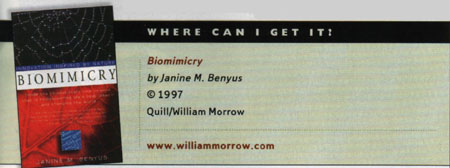Biomimicry
Reviewed by Richard Walthers

I recently participated in a panel discussion at a conference hosted by Yale University entitled "The Good in Nature and Humanity: Connecting Science, Religion, and the Natural World". Several hundred scientists, religious leaders, conservationists, architects, farmers, foresters and fisherman came together to explore the connections between spiritual and scientific understandings of nature. Aldo Leopold—one of Yale’s more famous graduates from its School of Forestry—was quoted so extensively during the conference by both speakers and attendees that everyone began to make light of it during the latter part of the conference.
The humor was always the self-deprecating variety at the expense of the speaker, with no intent to trivialize Leopold’s words. Far from it, as a reading of any of Leopold’s work shows how important and prophetic his ideas were. In A Sand County Almanac, Leopold states that "The most important characteristic of an organism is that capacity for internal self-renewal known as health." In the same context, he also states "The effort to control the health of land has not been very successful." In For the Health of the Land, published to celebrate the 50th anniversary of the publication of A Sand County Almanac, Leopold continues to further develop the idea of ethical land use into the concept of land health. This book consists of a series of essays and articles, some of which have never been published before.
The essence of Leopold’s concepts of promoting healthy land and its resultant biodiversity and fecundity are just as valid today as when they were first written in the 1930’s and 1940’s for the benefit of small farming operations. Though he was writing mainly for this specific group, I think Leopold would be very happy to see the larger and enthusiastic audience that his work has attracted over the last three decades.
In the last essay of the book, which he left in pencil draft at his death, Leopold discusses the land health issue and its relationship to conservation, and the need for urgent action. How advanced was his thinking 50 years ago when he said we should not wait for ecologists to get all the answers before we act? And what would he think of us as we still debate the merits of various environmental initiatives we know to be sound but refuse to act on?
Leopold writes that stability is characteristic of new or undisturbed land. "Another characteristic of new land is diversity. The biotic community is diverse in composition, complex in organization, and tends to become more so." Throughout his essays, Leopold warns against eliminating unwanted species (what he called "the needless pruning of species list") or allowing habitat destruction to cause a decline in the richness of life.
Leopold understood that all land would be converted in some way to support our industrial economy, but he also understood that the less violent the conversion was, the more likely it was to be durable and be free from unforeseen repercussions. Wetlands drainage, flood-control dams, hydroelectric dams, the reckless use of new poisons in agriculture (as early as 1945 he warned against the use of DDT), wildlife control, and fish and forestry management are all part of what Leopold calls "the philosophy of violence." Because these man-made controls are quicker to implement than natural ones, they are assumed to be superior. All these issues are still being argued and fought over today.
The essential idea that is central to all of Leopold’s writing is the way he marries a Midwestern sense of practicality with his lofty ecological ideals. Even though I feel that Leopold’s writing in A Sand County Almanac was more poetic and lyrical than this book of essays, The Health of the Land was written with a more practical goal in mind for land owners. He describes a way for both wild lands and working landscapes to become healthy and productive. We have spent the last several centuries taking nature apart and studying the pieces. Leopold offers us an awareness of the wholeness of nature.
Robert Perschel, Co-Chair of the Land Ethic Program of The Wilderness Society, asked at the Yale Conference, "How do you reconnect people to the land?" The time is right for everyone to read Leopold again, and this new book provides a conservation message for anyone seeking practical solutions. Leopold provides the outline of a plan—and no one can dispute his powerful and prophetic environmental vision—that can allow us all to reconnect to the land, whether we are urban or rural.
Leopold writes that "the true problem of agriculture, and all other land-use, is to achieve both utility and beauty, and thus permanence." It becomes our job, no matter what type of work we do, to integrate our work with our connection to the land—because this is where each of us faces the challenge of ethical resource use on a daily basis. As Leopold said, the number one reason for practicing conservation is that it "adds to the satisfactions of living."